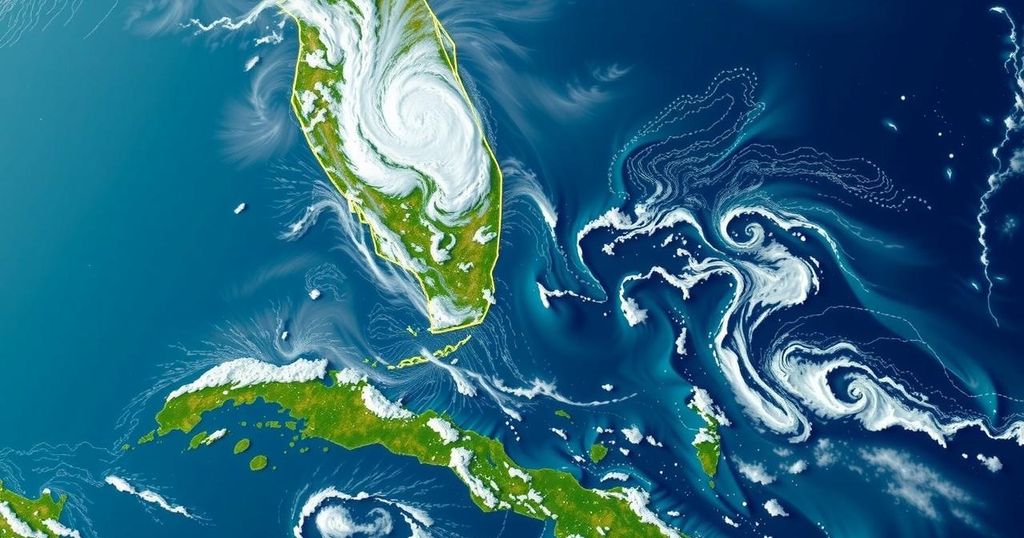Current Status of Tropical Invests 94L and 95L: Impacts and Expectations for Florida
The National Hurricane Center is monitoring two invests, 94L and 95L, neither of which poses a direct threat to Florida. Invest 94L is expected to impact Puerto Rico and Hispaniola, while Invest 95L may affect Central America and Mexico. Both systems have low chances of developing into significant storms, and tropical development in the Caribbean is expected to remain minimal over the next two weeks.
The National Hurricane Center (NHC) is currently monitoring two tropical invests: 94L and 95L. Fortunately for Florida residents, neither invest poses a significant threat to the state at this time. Invest 94L, which showed potential earlier in the week for developing into Tropical Storm Nadine, is anticipated to bring heavy rains to Puerto Rico and Hispaniola instead. Meanwhile, Invest 95L has emerged with some potential for short-lived development, likely affecting Central America and Mexico by the weekend. According to a recent advisory from the NHC, while both invests are being tracked, the probability of significant development over the next week is low. A two-week forecast from Colorado State University meteorologists indicates that no tropical development is expected in the Caribbean through October 28, with a 50% chance of further tropical activity in late October. Despite these alerts, the forecasters assure that wind shear conditions may help limit any imminent threats from these systems to the continental United States. “I am confident that the next week and a half will be free of the conepanics associated with tropical threats to the continental United States,” stated Dr. Ryan Truchelut, chief meteorologist with WeatherTiger. Currently, Invest 94L consists of a poorly organized trough of low pressure with minimal chances for rapid development, moving westward at approximately 20 miles per hour. This system could potentially bring rainfall and gusty winds to northern Caribbean islands but is not expected to threaten Florida. Invest 95L, located in the northwestern Caribbean Sea, shows slightly better-defined activity and may develop into a short-lived tropical depression before making landfall in Belize and the Yucatan Peninsula of Mexico. Nevertheless, significant rains are also expected for Central America regardless of its development status. Additionally, the NHC has clarified the term “invest,” which refers to areas of low pressure under investigation for potential tropical cyclone development. It is essential to note that these invests are not yet classified as tropical depressions or storms. As the Atlantic hurricane season continues until November 30, it is prudent for residents to remain aware of any advisories from the NHC, as conditions can change rapidly. The peak of the hurricane season, typically observed around September 10, has passed, yet the possibility for late-season storms still exists. The NHC confirmed that it is not tracking any other disturbances in the Atlantic basin, thus further updates will be provided as necessary, and individuals are encouraged to maintain vigilance as weather events develop.
The National Hurricane Center is responsible for monitoring and forecasting tropical weather systems in the Atlantic basin, which includes the Caribbean Sea and the Gulf of Mexico. The peak of the Atlantic hurricane season occurs around September, but remnants of potential storms can continue to form into late October and early November. Given the intense climatological activities associated with tropical systems, inhabitants of vulnerable regions, particularly along the Gulf Coast and Atlantic Seaboard, need to remain informed about any potential threats. The concept of “invests” allows meteorologists to closely observe disturbances that may develop into more serious tropical systems, offering residents critical time to prepare for possible impacts, even before a storm is officially designated.
In conclusion, while both Invests 94L and 95L are under scrutiny by the National Hurricane Center, they do not pose a significant immediate threat to Florida. With low chances for development, particularly over the next week, residents can breathe a sigh of relief. However, given the historical tendencies of the hurricane season and the potential for future tropical activity in late October, it is advisable to remain vigilant and informed through official meteorological updates.
Original Source: www.news-journalonline.com




Post Comment